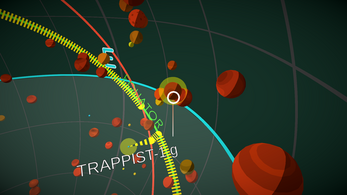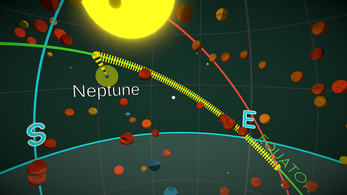🌌 Exoplanet Viewer
EXOPLANET VIEWER is an interactive visualisation of all the exoplanets that have been discovered so far. The data comes directly from the NASA Exoplanet Archive, and shows only the ones that have been confirmed. Out of the 5299 exoplanets confirmed, only the 936 with known distance, radius and temperature are shown.
This visualisation is in constant evolution; the last update is from March 2023.
Please, feel free to suggest new features.
- Twitter: @AlanZucconi
- Patreon: AlanZucconi
If you are interested in more visualisations about exoplanets, I have also worked on the Exoplanetary Catalogue.
Controls
- ⌨️ WASD. Move around the Celestial Sphere.
- 🖱️ Mouse. Look around.
- 🖱️ Click. Select an exoplanets for more info.
- 🖱️ Right Click. Zoom in.
Features
- 🌐 Celestial Sphere. Exoplanets Viewer shows the position of the exoplanets on the sky, as seen from you current location and time.
- 🔭 Celestial Coordinates. By clicking on a planet, you can see its celestial coordinates (right ascension and declination). You can use to find the position of the exoplanets in the sky.
- 🌌 Solar System. The planets of the Solar System are included in this interactive visualisation. They are rendered with the exact same technique of the other exoplanets.
- 📏 Sizes to scale. The relative sizes of the exoplanets are correct. Radii and distances uses different scales.
- 📏 Distances to scale. The distances of the exoplanets are to scale. When clicking on an exoplanet, you can count the notches on its diagonal line to find its exact distance from the Earth. For the one outside the Celestial Sphere, one notch corresponds to approximately 100 parsecs.
- 🌡️ Temperatures. The colour of a planet indicates its temperature. Most of the exoplanets are incredibly hot, hence why they look red. Planets in the habitable zone are green, while ice worlds are blue.
- ⚖️ Densities. The density of an exoplanet determines its aspects in this visualisations.
- Rocky planets (density > 2 g/cm³): craters on the surface.
- Gas giants (density < 1 g/cm³): cloudy surface.
- Other gas giants: rendered with the characteristic patterns that appears on Jupiter
| Status | Released |
| Platforms | HTML5 |
| Rating | Rated 5.0 out of 5 stars (1 total ratings) |
| Author | Alan Zucconi |
| Genre | Simulation |
| Made with | Unity |
| Tags | 3D, exoplanets, Experimental, First-Person, kepler, nasa, seti, Space, Unity |
| Average session | A few minutes |
| Languages | English |
| Inputs | Keyboard, Mouse |
| Accessibility | High-contrast |
| Links | Twitter/X, Homepage |



